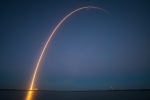NASA Fuel Shortage: Will Plutonium Scarcity End Deep-Space Exploration By 2020?


NASA is running out of fuel. According to Wired, the nation's civilian space program is dangerously low on plutonioum-238, a radioactive isotope that NASA uses to power its space probe missions. In fact, its current stockpile will last only until about 2020.
Like Us on Facebook
Exactly how much plutonium-238 does NASA have in its storehouse? Yahoo reports that the government program has just 36 pounds left. That might sound like a lot -- or a little, depending on how familiar you are with plutonium-238 -- but consider that a single plutonium-238 battery, like the one currently fueling the space program's Mars Curiosity rover, contains about 10 pounds of the isotope.
Plutonium-238 is an extremely efficient -- but extremely expensive -- fuel source. The isotope is made in a nuclear reactor, and can produce small quantities of electricity consistently for several decades. A single gram, or about .002 pounds, of plutonium-238 can produce .5 watts of power. A 10-pound chunk of plutonium can produce about 2,268 watts of power.
As the isotope breaks down, or decays, it releases energy. So much energy, in fact, that its temperature can reach 2,300 degrees Fahrenheit. A plutonium-238 battery is rigged in a way that turns this heat into power. This is called a radioisotope thermoelectric generator, or RTG.
"It's like a magic isotope. It's just right," Jim Adams, NASA's deputy chief technologist, told Wired.
There used to be a ton of it in space -- it was the product of exploding stars -- but that was billions of years ago. The isotope's half-life, the time it takes for half of the material to decay, is about 88 years. So it's long gone by now.
According to NPR, plutonium-238 batteries have powered about two dozen space missions since NASA's inception. That includes the Voyager probes in the 1970s (one of which recently exited our solar system), the Cassini spacecraft and the Mars Curiosity rover. It's even used in spy satellites.
But the plutonium-238 won't last forever.
"We've been living off of the material that we had produced up until that time, and if you keep using material and you have a finite supply, eventually you run out, and that's where we are right now," Ralph McNutt, a planetary scientist at the Johns Hopkins University Applied Physics Laboratory, told NPR in 2009.
Until recently, the U.S. hasn't made plutonium since the 1980s. They originally made it as a byproduct of Cold War activities. And after the U.S. stopped manufacturing the isotope, it started buying it from Russia. Their first shipment to the states was in 1993. It weighed 36 pounds and cost the U.S. $45,000 per ounce, or roughly $26 million for the whole batch. But that market shuttered in 2009.
According to the U.S. Department of Energy, the U.S. government has 87 pounds of plutonium-238 to divvy up between its departments. Two-thirds of it goes to national security projects. NASA gets just 36 of it.
Discovery News reported in March that we actually are starting to make plutonium in the U.S. again. "After encapsulating the radioactive starter material neptunium, putting it into a reactor at Oak Ridge National Laboratory in Tennessee and radiating it for a month, the [Department of Energy] did successfully generate plutonium," Discovery noted.
If scientists at laboratory can get things working properly, they could start producing about 3.3 pounds of plutonium a year.
Read more from iScience Times:
NASA's FINDER Device Detects Heartbeats Buried Under Rubble In Search-And-Rescue Operations
NASA Weather Drones Launched To Study Hurricanes And Help Improve Storm Forecasting
NASA TextureCam Will Enable Rovers To Analyze Space Objects On Their Own, Speeding Up Exploration
© 2012 iScience Times All rights reserved. Do not reproduce without permission.

25 Year Study Reveals Eco-Farming To Be Economically Feasible And Sustainable

How Methane-Producing Microbes Caused The Largest Mass Extinction The World Has Ever Seen

Terrifying Animatronic Robot Dances To 'Blurred Lines,' Causes Nightmares [VIDEO]

Scientists Demonstrate Three-Way Quantum Communication: What's Faster Than The Speed Of Light?

Woolly Mammoth DNA To Be Cloned, Then Joined With Elephant DNA To Create New Creature

Oculus Rift Headset Will Take You On A Trip To Space, All From The Comfort Of Your Couch



![How to Turn Your Tap Water Faucet Into a Coffee Spout [VIDEO]](../../../cdn-sub/data/thumb/mainpage/6005-150100-coffee.jpg)

